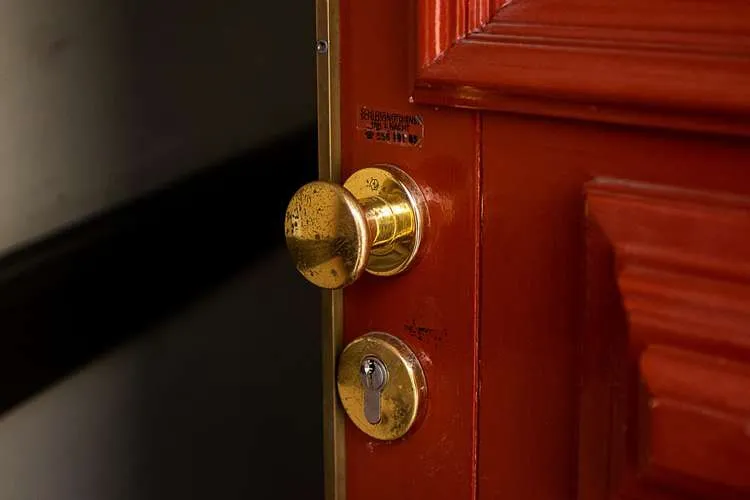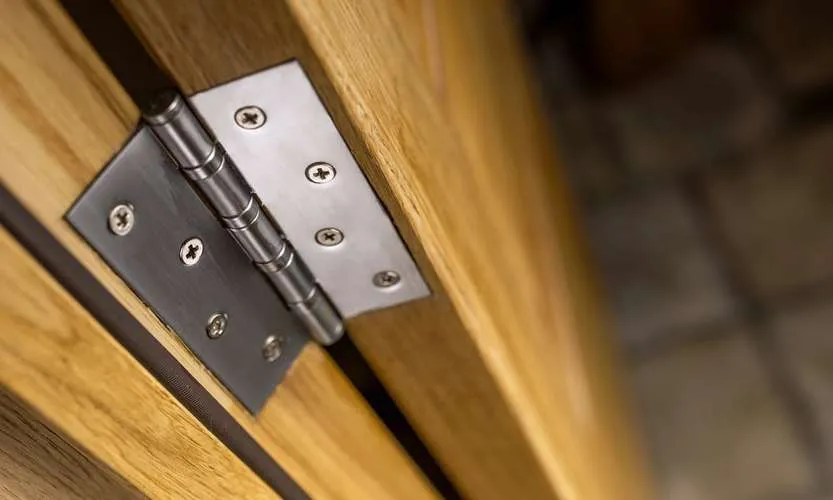Frustrated by your door that won’t latch? There can be many possible reasons why your door won’t stay shut. It could be due to frequent use for years, or you just upgraded your front door hardware and for some reason, it refuses to close.
Here’s a short guide on how to troubleshoot common door problems to regain your sense of privacy and security at home.
Common Causes Why Your Door Won’t Close

The first thing you should do to fix a door that won’t close is to determine the cause of the problem. Is it a loose hinge? A misaligned hinge or strike plate hole? The reasons could vary and once you know the root cause, you’ll realize that these are fairly easy to fix.
Here are the common things you should look for:
Door Hinges
Door Latches
Door Jambs
Tools You Will Need
Fixing your door issues is easier when you have the right tools. Depending on the problem, you might need some of the tools below:
- Wood chisel
- Hammer
- Drill bit set
- Philips-head screwdriver
- Cordless drill
- Metal file
- Utility and putty knives
- Wood filler
How to Fix a Door That Won't Close or Latch: Step by Step
Step 1: Diagnose the Problem

Step 2: Adjust the Hinges

Not sure why your door sags? Then loose hinges could be the culprit. A quick fix could be tightening the loose screws using a screwdriver. But be careful - don’t make it too tight to prevent changing the door’s plumb!
If the door still won’t latch after adjusting the screws, then try to replace one of the hinge screws with a 3-inch screw. The reason why we chose a longer screw is to pull the door jamb slightly to the hinge side. This will fit the latch tightly on the strike plate hole.
Step 3: Lower or Raise the Strike Plate
Sometimes, you will find that the culprit is a latch that is slightly below the strike plate hole. You can either lift the latch by replacing the top screw of the hinge, or lower the latch by replacing the bottom screw of the hinge. Make the necessary adjustments until the latch perfectly fits the hole.
Also, try to push the strike plate down to accommodate the latch. Get a chisel and point it to the strike plate’s lower lip. Using a hammer, strike the chisel gently downward until the plate is about 1/8-inch down. Adjust accordingly until the latch fits on the strike plate hole.
Here's a video on how you can fix a misaligned strike plate:
Step 4: Adjust the Hole Size of the Strike Plate
If the issue is not a loose hinge or a latch that sits below the strike plate hole, then you may need to enlarge the strike plate hole.
First, remove the screws that hold the strike plate to the door jamb. Then move the metal file back and forth rapidly through the strike plate hole, focusing on the lower lip. This will remove some metal from the plate and create enough clearance to accommodate the latch. Try to reinstall the strike plate and check if this solves the problem.
Step 5: Change the Strike Plate Position
Step 6: Mark the Strike Plate’s New Position
The goal of this step is to change the position of the strike plate while preventing the old screw holes from overlapping the latch hole. Move the strike plate about 1/8 or 1/16 inches below the old screw hole and mark the new position using a pencil.
Also, mark the position of the new screw holes on the door jamb (use the screw holes on the plate). This will be your guide later on when drilling the plate on the door.
We also recommend that you mark the bottom edge of the plate with a line. The line will be your guide when chiseling the area to fit the plate.
Step 7: Fill in the Old Screw Holes
Once you’ve marked the new screw holes position, you need to fill in the old screw holes to prevent the screws from being accidentally placed in the old holes.
To do this step, you can either use a wood filler or glued toothpicks. If you’re going to use the glued toothpicks, make sure that you dab enough super glue on the toothpicks to stick it well into the holes. Push the toothpicks deep inside as far as possible. Do this until the old screw holes are filled. Allow at least 10 minutes for the toothpicks to settle in the hole before trimming its hanging side with a utility knife.
Step 8: Drill New Screw Holes
Once everything is set, it’s time to drill the new holes!
We highly recommend that you start making small holes first on the markings you’ve made earlier. This will guide the drill bit later on (and prevent it from sliding to the wrong position). Do this using a pinhole nail and hammer.
Then, attach the smallest drill bit and start drilling. Use the small holes you’ve made as a guide. After drilling a small hole, change the drill bit to the next size and continue drilling. The idea is to gradually increase the size of the hole. This will create a clean hole and protect the jamb from any damage.
Step 9: Chisel Out the Mark for the New Strike Plate Position
Now that the new screw holes are ready, it’s time to chisel out the new position of the plate. Remember the trace line you’ve made at the bottom edge of the plate? This will be your guide to create the space for the plate.
Use a utility knife to gently cut the marked line you’ve created. Run through this line several times until it’s deep enough to fit the chisel. Point the chisel to the gorge and gently strike a hammer to remove some pieces of wood (make sure not to damage the door jamb).
Create a clean wedge to perfectly fit the strike plate to its new position.
Step 10: Reinstall the Strike Plate
Additional Tips
Make sure to lubricate locks
When to Call A Professional
Conclusion
Hi, I’m Christy, and I’m an electronics engineer by profession. I have taught in a university for 2 years while pursuing my master’s degree in cognitive radio and worked for a company to develop wireless medical devices. Currently, I’m doing research for a doctorate degree in engineering using a wireless sensor network for smart agriculture. I’ve been active in our local IoT community, IoT Cebu, where I participate in conducting talks about Arduino, Raspberry Pi, and DIY home automation using Wi-Fi and ZigBee devices.
